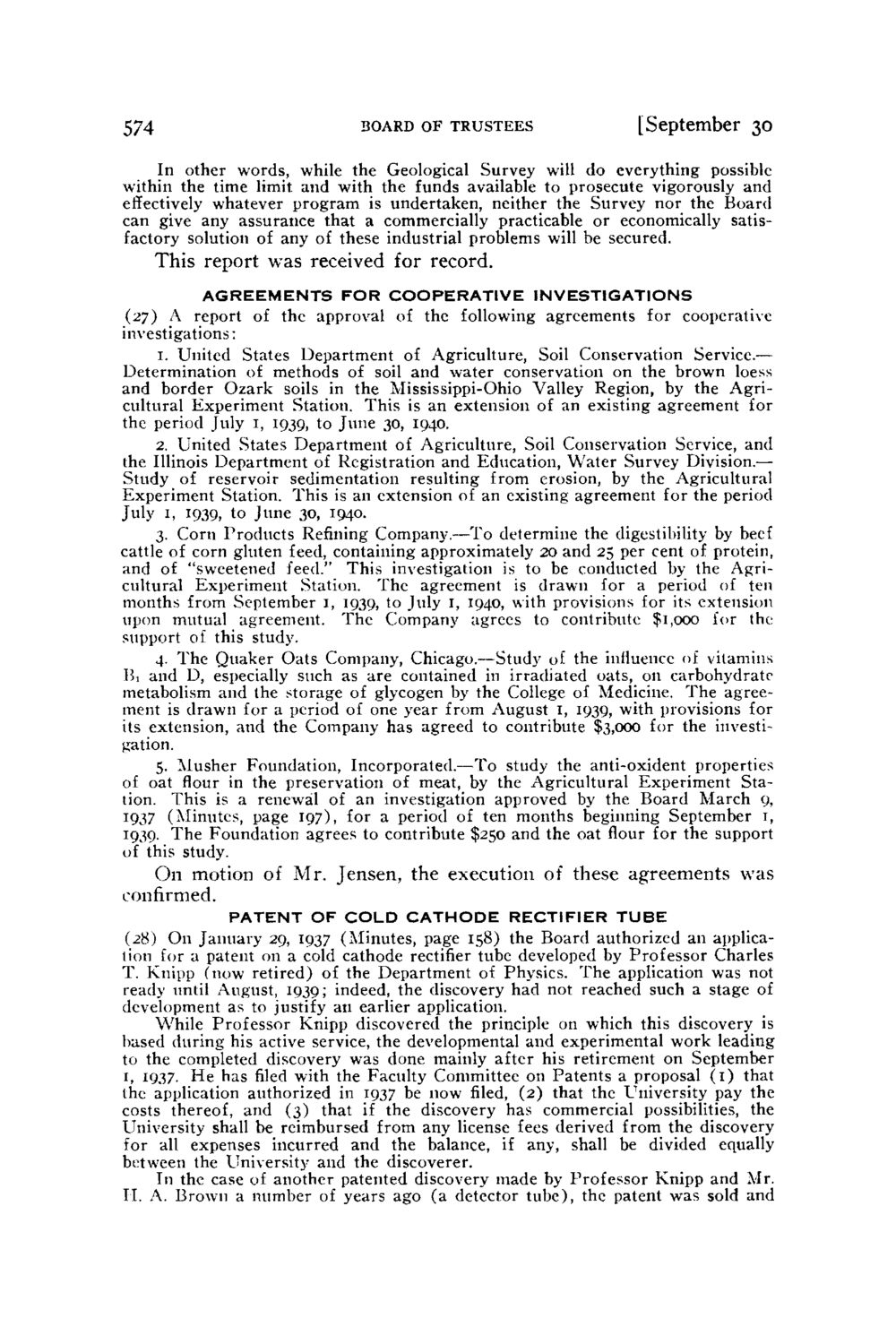| |
| |
Caption: Board of Trustees Minutes - 1940
This is a reduced-resolution page image for fast online browsing.

EXTRACTED TEXT FROM PAGE:
574 30ARD OF TRUSTEES [September 30 In other words, while the Geological Survey will do everything possible within the time limit and with the funds available to prosecute vigorously and effectively whatever program is undertaken, neither the Survey nor the Board can give any assurance that a commercially practicable or economically satisfactory solution of any of these industrial problems will be secured. This report was received for record. AGREEMENTS FOR COOPERATIVE INVESTIGATIONS (27) A report of the approval of the following agreements for cooperative investigations: 1. United States Department of Agriculture, Soil Conservation Service.— Determination of methods of soil and water conservation on the brown loess and border Ozark soils in the Mississippi-Ohio Valley Region, by the Agricultural Experiment Station. This is an extension of an existing agreement for the period July 1, 1939, to June 30, 1940. 2. United States Department of Agriculture, Soil Conservation Service, and the Illinois Department of Registration and Education, Water Survey Division.— Study of reservoir sedimentation resulting from erosion, by the Agricultural Experiment Station. This is an extension of an existing agreement for the period July 1, 1939, to June 30, 1940. 3. Corn Products Refining Company.—To determine the digestibility by beef cattle of corn gluten feed, containing approximately 20 and 25 per cent of protein, and of "sweetened feed." This investigation is to be conducted by the Agricultural Experiment Station. T h e agreement is draw7n for a period of ten months from September 1, 1939, to July I, 1940, with provisions for its extension upon mutual agreement. T h e Company agrees to contribute $1,000 for the support of this study. 4. T h e Quaker Oats Company, Chicago.—Study of the influence of vitamins Hi and D, especially such as are contained in irradiated oats, on carbohydrate metabolism and the storage of glycogen by the College of Medicine. The agreement is drawn for a period of one year from August I, 1939, with provisions for its extension, and the Company has agreed to contribute $3,000 for the investigation. 5. Musher Foundation, Incorporated.—To study the anti-oxident properties of oat flour in the preservation of meat, by the Agricultural Experiment Station. This is a renewal of an investigation approved by the Board March 9, 1937 (Minutes, page 197), for a period of ten months beginning September 1, 1939. T h e Foundation agrees to contribute $250 and the oat flour for the support of this study. On motion of Mr. Jensen, the execution of these agreements was confirmed. PATENT OF COLD CATHODE RECTIFIER TUBE (28) On January 29, 1937 (Minutes, page 158) the Board authorized an application for a patent on a cold cathode rectifier tube developed by Professor Charles T. Knipp (now retired) of the Department of Physics. T h e application was not ready until August, 1939; indeed, the discovery had not reached such a stage of development as to justify an earlier application. While Professor Knipp discovered the principle on which this discovery is based during his active service, the developmental and experimental work leading to the completed discovery was done mainly after his retirement on September I, 1937. H e has filed with the Faculty Committee on Patents a proposal (1) that the application authorized in 1937 be now filed, (2) that the University pay the costs thereof, and (3) that if the discovery has commercial possibilities, the University shall be reimbursed from any license fees derived from the discovery for all expenses incurred and the balance, if any, shall be divided equally between the University and the discoverer. In the case of another patented discovery made by Professor Knipp and Mr. II. A. Brown a number of years ago (a detector t u b e ) , the patent was sold and
| |